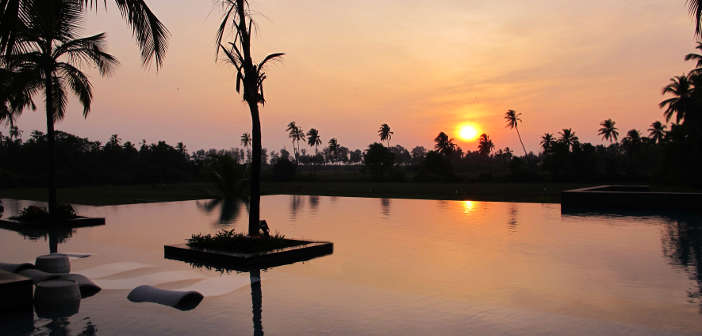As the BBC’s Hotel India continues to grace our small screens, we continue with the second part of Noah’s travels through the sub continent. Here, he heads south from Mumbai to the coast, and to that fabled Xanadu for spiritually-minded, beach-obsessed Brits, Kerala…
Mumbai’s Dadar station heaves with all human life. The heat is suggestive of a fiery sauna, but a sauna that has been stuffed full of an improbable array of characters and ingredients. The station is redolent of sweat, cooking fat and ripe vegetables, and the temperature is rising. At the entrance to the station a troupe of porters clad in blood red shirts and bandanas fight for the privilege of helping with luggage; by the time you’re on the platform you feel as if you’ve been sparring all morning. The platform itself is strewn with men, women, children and a zoo of animals: there are goats, chickens and a profusion of dogs basking in the late morning sun. Men bask too, and women – lying on the floor, as if in death. It is quite a worry, initially. Finally, after many negotiations, we make our way to the required section of the platform to await our train – The Netravati Express.
The journey is going to be long and there is potential for ardour; we’re travelling in AC2, which should be heavenly and cool, but the berth is six deep, so who knows what weird and wonderful characters we might encounter. Our journey to Kerala, via Goa, will take us out of our comfort zone and deep into India’s rural south. We will traverse over 1200km of the ragged coastal route that has linked the metropolises of the north to the sleepy coastal backwaters for over 100 years. The train is a sturdy old relic; I could not hope to date it accurately, but I would imagine the train to be close to its half-century. There is a well-worn patina that speaks of decades of dedicated service to the railways and people of India.
The train is full, there is not a spare seat to be found, and as this iron beast leaves Mumbai and gathers speed, the real commotion begins. Families disperse then congregate and move around to try to find comfort. Indian Railways staff start making their way through carriages, bringing blankets and pillows and then returning to take lunch and dinner orders. As these characters disperse, new faces arrive, pushing through the greasy old cotton dividers that separate berths. The first vendors’ calls are for samosas then more for chai, coffee and sandwiches. Over the next twenty seven hours, hundreds of keen vendors will pass us, offering a dizzying array of produce to cater for almost all possible tastes. The only taste that isn’t condoned is one of my own favourites. When I discreetly slip a half bottle of 18 Year Old Johnny Walker out of my bag and pour it into paper cups for my wife and I, my actions are met by a steely shake of the head – no booze allowed on Indian Railways. A little harsh, seeing as these are the longest journeys in Asia. Finally, we manage to find a comfortable position for slumber and slowly drift off, the jolting movement of The Netravati Express keeping sleep light, my head pressed against the cool metal of the train, only inches separating my head from the enormity of India beyond.
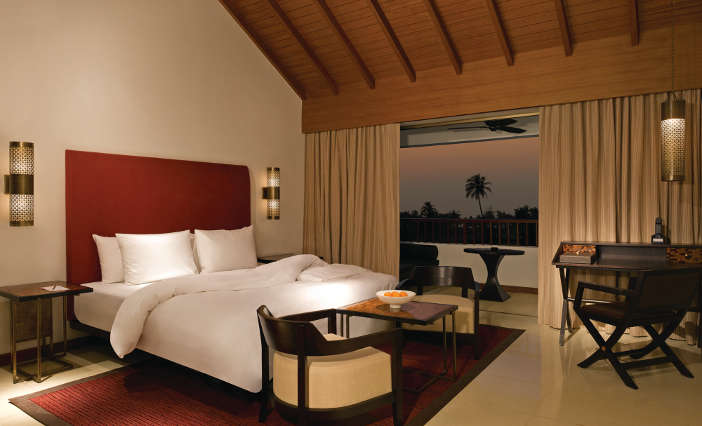
Goa is a mysterious anomaly in the historical and cultural structure of India. The area was colonised primarily by the Portuguese and it is their architectural and gastronomic imprint that can still be seen clearly today. The area was most recently ‘colonised’ by the original hippies of the 1970s and has, since then, been known as one of the most liberal and permissive areas of a generally culturally conservative India. We are headed for the south of the region, which has an elegant, laid-back dynamic and a growing selection of excellent hotels that cater for discerning travellers to the region.
We arrive at Madgaon Junction, one of Goa’s busiest train stations, but still seems like a relaxed little outpost in comparison to the uninhibited madness of Mumbai. We are travelling to Alila Diwa, one of the region’s smartest hotels. The hotel opened five years ago and is part of a group of medium-sized, luxury hotels with properties across the country. The hotel is particularly well known for its award-winning regional Indian restaurant Spice Studio, which won best Indian Restaurant in Goa in the Times of India Restaurant Awards. The hotel is set across several acres amid the lush greenery of paddy fields and palm trees. We are lucky enough to secure a room with a view: the category is a Loft Room, with a balcony that looks out over the roofs of the hotel and then further out across the paddy field where now, in the dry season, cows share the space with wild boars and storks.
Our visit to Alila Diwa coincides exactly with the final days of the election process and to reflect these momentous events, the head chef at Spice Studio has devised a menu that celebrates the regional specialities of India. We are seated at a table with an excellent view of the action that is developing in the kitchen and we then survey the menu. We begin with an unusual dish that originates from the far north east of the country, where India’s border meets China. The dish arrives in a bamboo steamer and, at first glances, looks akin to dim sum. The steamed dumpling would indeed be at home in any Hong Kong diner, but the meat inside – fiery spiced lamb – is Indian in temperament. We follow with a classic Goan fish curry, a dish that forms the backbone of the traditional diet for many in the region. The fish in question is king fish, or Spanish mackerel as it is sometimes known. The curry is a simple construction with chilli, turmeric and coconut as the central elements. The chilli has some kick, but they’re sweet, Kashmir chillies, so there is a wonderful balance of sweetness and heat.
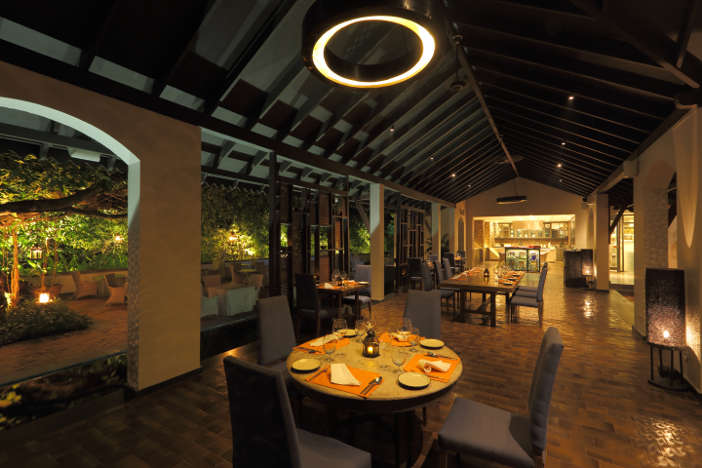
Morning comes with a soft, hazy light. We rise early while the air is still coolish and make a journey into Madgaon, to the fish market. Madgaon’s central district is peopled with all manner of character, even at this early hour. The markets are separated into fish, meats, fruit and vegetables and each easily fills a colonial-era building of such crumbling, rumpled splendour that it catches you off guard. We make our way into the throng and begin the process of securing the freshest bounties from today’s catch. Our guide is knowledgeable and quick; he moves deftly around the stalls looking carefully at eyes and prodding gills, to check for pinkness. The variety of fish available is staggering: everything from sardines and tiny, filigree shrimp, through to sharks and tuna fish weighing in at over 100kg. We opt for half a dozen tiger prawns the size of small lobsters and a handsome, sparkling red snapper.
Back at Alila Diwa and we make quick work in the kitchen preparing our catch. The chefs advise how best to clean, de-scale and gut our fish. Then comes the spicing and preparation of the curry base, a thick paste that’s drawn from chilli, garlic, ginger turmeric, cumin and tamarind and then yoghurt to provide texture. Our snapper is heading toward the fiery heat of the tandoor oven and must be properly prepared. Alongside the fish, we enjoy a magnificent Goan prawn curry, with our tiger prawns from the market. As we sit to eat in the smart open-sided dining room in Spice studio, the weather turns. There has been tension in the air all day, and in an instant that tension boils over into a rain storm that offers a ferocity unlike any I’ve seen in India. The heavens seem to turn in on themselves and the world receives a comprehensive thrashing. Semi-safe in the restaurant we try to focus on the food at hand which is superb, but the dramatics outside are a drain on our attention.
By morning, the sun has returned. We board the train at Madgaon and resolve ourselves to the long ride ahead. Kerala is a serene landscape of lush greenery and white sand that gives way to sensual, meandering backwaters, feeding into beautiful lakes. Our train journey takes us to Fort Cochin, an old colonial coastal town that was once an outpost for both the British and the Dutch. The town is best known for the famous Chinese fishing nets, huge, gnarled wooden structures, reminiscent of Louise Bourgeois spiders, that were first erected in the 18th century and still line the coast today.
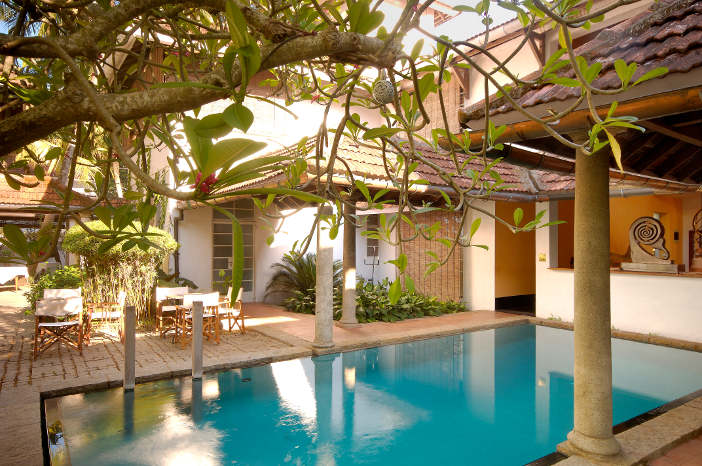
Malabar House is perhaps the finest boutique hotel in the region. The property, which is found on the corner of the parade ground in the old town, occupies an excellent position, set back from the throng that congregates around the centre of town. The hotel is well-loved among European travellers for its stylish rooms, excellent restaurant and relaxed atmosphere.
We arrive feeling very weary and a little jaded after the long train journey. We’re both in need of rejuvenation and a rest. The hotel is a arranged around a light-filled central courtyard with a pool in the centre and rooms fanning out around the upper corridors. Our room is filled with the warmth of an afternoon sun, but also enjoys carefully set air conditioning, so an equilibrium is achieved and we are able to cool down at leisure, to bathe in comfort and gather our thoughts. Once refreshed, we enjoy some quiet repose on our balcony in the sun, before preparing for dinner at Malabar Junction.
The restaurant is on the ground floor and enjoys an open-sided frontage which lets in light and allows diners to enjoy an alfresco environment whilst protected from the oppressive heat and sometimes unpredictable weather. The cuisine is that of the coastal south and in particular of this Malabar Coast, but there are some subtle European influences too. This area of the Indian coast is famed for its shellfish and for the delicate flavours of the local specialities: the fresh, young coconuts and lighter flavoured chilli and citrus fruits. The style of cooking here is not dogmatically traditional though. There is a clear sense of the culinary heritage of the Malabar Coast, but there are also nods to Western cuisine, in the form of ingredients and presentation that falls outside of the South Indian tradition. The wine list at Malabar Junction offers a wide selection of bottles from several of India’s most famous wine producers. We enjoy excellent, fresh vibrant Sauvignon Blanc and powerful, unctuous Viognier from Sula, whose winery and vineyards are situated in Nashik in the Maharashtra. The wines that do well in these valleys of North India are those with light, aromatic character that can cope with some heat – the Viognier was particularly interesting. We retire to rest in the cool of our room, the flavours of the region and sounds of the town reverberating softly through our sleepy minds.
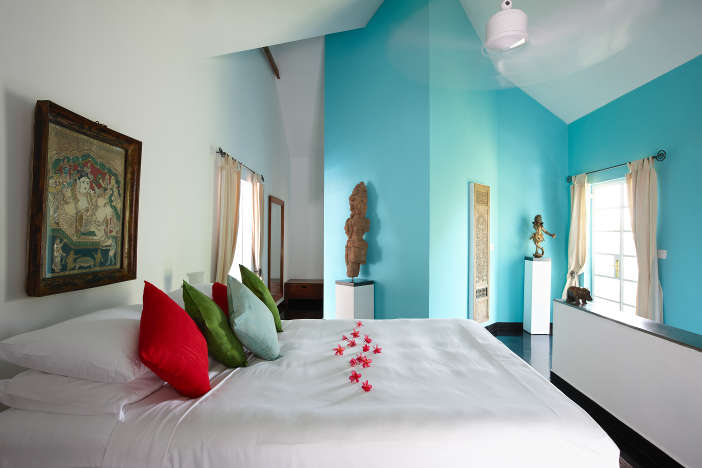
From Cochin, we take a short, but terrifying taxi ride to our next stop, Purity, on the banks of Lake Vembanad. Purity is the sister hotel to Malabar House, but whilst similarities between the two properties can be observed, Purity has a character and singular charm all of its own. Where the aesthetics of Malabar House were focused on its history and the hotel’s place within an ancient colonial town, Purity is unique in that its modern interior design is set against the classic Keralan architecture. The property is filled with pieces of South Indian contemporary art, which reflects the owner’s strong links to the art world. Before moving to India and into the world of hotels, he was an art dealer based in Bavaria. One artist whose work is celebrated here is Abdul Kalam, a photographer-turned-artist whose work reflects the South Indian landscape. The walls of the property are covered in unique pieces and rooms benefit from bright linens and deep-coloured fabrics and artworks. Purity only has ten rooms and two suites, and when we make our visit, the property is moving into low season, which means, amazingly, we are the only guests staying at the hotel. Our room is stylish, spacious and offers pleasingly varied aesthetic detail. The main tone is of clean lines hewn from stone and marble, to which is added natural wood in various shades. Indian Contemporary Art and vibrant prints complete the picture; this is a room to luxuriate in, a room to share quiet hours with a loved one.
A walk down through the hotels gardens and to the pool-side offers extraordinary tranquillity. Lake Vembanad sits ahead of us in a state of perfect calm, spreading out toward the horizon. Not a ripple breaks the stillness of the waters. As the hotel is all-but-empty in this period before the approach of the monsoon season, the restaurant is closed, which means that in essence, we have our own private chef. Rather than choosing to dine in the hotel, we make the decision to eat by the lake, to sit and soak up the soft, night air. We don’t choose from the menu; we ask Chef to select dishes that reflect the region’s gastronomic riches. Under the light of a waning moon, we feast on king fish with fresh chilli and tamarind and prawns simmered in mango and young coconut. You would struggle to find a meal so satisfying on this earth. We sit and breathe in the warm, southern quiet of night, and reflect on the extremes that India has offered us, as visitors. The tranquillity, the otherworldly calm suddenly seems unthinkable set against the backdrop of this fervent, exhausting sub-continent. We enjoy it for this transient moment, knowing that we’ll return to the commotion before we have chance to properly catch our breath.
Alila Diwa, 48/10, Village Majorda, Adao Waddo, Salcette, Goa 403713, India. Book Now.
Malabar House, 1/268 – 1/269, Parade Road, Fort Kochi, Kochi, Kerala 682001, India. Book Now.
Purity, Meppuram Rd, Aryakara, Ward 5, Muhamma, Kerala, India. Book Now.

